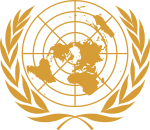- Dumbarton Oaks Conference
-
The Dumbarton Oaks Conference or, more formally, the Washington Conversations on International Peace and Security Organization was an international conference at which the United Nations was formulated and negotiated among international leaders. The conference was held at Dumbarton Oaks from August 21, 1944 through October 7, 1944.
 Dumbarton Oaks in Washington, D.C. was the location of the conference.
Dumbarton Oaks in Washington, D.C. was the location of the conference.
Contents
Overview
The Dumbarton Oaks Conference constituted the first important step taken to carry out paragraph 4 of the Moscow Declaration of 1943, which recognized the need for a postwar international organization to succeed the League of Nations. At the conference, delegations from China, the Soviet Union, the United Kingdom, and the United States deliberated over proposals for the establishment of an organization to maintain peace and security in the world. Among the representatives were the British Permanent Under-Secretary of State for Foreign Affairs, Sir Alexander Cadogan; Soviet Ambassador to the United States, Andrei Gromyko (1909–1989); Wellington Koo (1887–1985), Chinese Ambassador to the United Kingdom; and U.S. Undersecretary of State Edward Reilly Stettinius, Jr. (1900–1949), each of whom chaired his respective delegation. (When Cadogan was called back to London after the first half of the conference, leadership of the delegation was assumed by E. F. L. Wood, 1st Earl of Halifax, the British ambassador in Washington.[1]) The conference itself was chaired by Stettinius,[2] and U.S. Secretary of State Cordell Hull (1871–1955) delivered the opening address.
The conversations were held in two phases, since the Soviets were unwilling to meet directly with the Chinese.[3] In the first phase, representatives of the Soviet Union, the United Kingdom, and the United States convened between August 21 and September 28. In the second, representatives of China, the United Kingdom, and the United States held discussions between September 29 and October 7.
The setting
Robert Woods Bliss (1875–1962), who with his wife, Mildred Barnes Bliss (1879–1969), had given Dumbarton Oaks to Harvard University in 1940 to establish a scholarly research institute and museum in Byzantine studies, was instrumental in arranging for these meetings. Already in June 1942, on behalf of the director, John S. Thacher, and the Trustees for Harvard University, he had offered to place the facilities of Dumbarton Oaks at the disposal of Secretary Hull. When in June 1944 the State Department found that Dumbarton Oaks could “comfortably accommodate” the delegates and that “the environment [was] ideal," the offer was renewed by James B. Conant, the president of Harvard University, in a letter of June 30, 1944.
Goals and outcomes
The stated purposes of the proposed international organization were:
- To maintain international peace and security; and to that end to take effective collective measures for the prevention and removal of threats to the peace and the suppression of acts of aggression or other breaches of the peace, and to bring about by peaceful means adjustment or settlement of international disputes which may lead to a breach of the peace;
- To develop friendly relations among nations and to take other appropriate measures to strengthen universal peace;
- To achieve international co-operation in the solution of international economic, social and other humanitarian problems; and
- To afford a center for harmonizing the actions of nations in the achievement of these common ends.
On October 7, 1944, the delegates agreed on a tentative set of proposals (Proposals for the Establishment of a General International Organization) to meet these goals. The discussions at the conference regarding the make-up of the United Nations included which states would be invited to become members, the formation of the United Nations Security Council, and the right of veto that would be given to permanent members of the Security Council. Charles E. Bohlen writes that the Dumbarton Oaks Conference "settled all but two issues regarding the organization of the United Nations—the voting procedure in the Security Council and the Soviet pressure for the admission of all sixteen of the Soviet republics to the General Assembly. It took the conference at Yalta, plus further negotiations with Moscow, before these issues were solved."[4] Also at Yalta, a trusteeship system was proposed to take the place of the League of Nations mandate system. At the United Nations Conference on International Organization, also known as the San Francisco Conference, in April–June 1945, the Security Council veto powers were established and the text of the United Nations Charter was finalized.
See also
References
- ^ Reston, James B. (30 September 1944). "China Takes Place in Security Talks; Soviet Phase Ends". New York Times. http://search.proquest.com.ezp-prod1.hul.harvard.edu/docview/106850643?accountid=11311. Retrieved 15 September 2011.
- ^ Stettinius, Edward Reilly, Jr. The Columbia Encyclopedia, Sixth Edition. 2001-07
- ^ Reston, James B. (21 August 1944). "World Plan Talks Will Start Today". New York Times. http://search.proquest.com.ezp-prod1.hul.harvard.edu/docview/106797230?accountid=11311. Retrieved 15 September 2011.
- ^ Bohlen, C.E. (1973). Witness to History, 1929–1969. New York. p. 159.
Further reading
- Hilderbrand, Robert C. (1990). Dumbarton Oaks: The Origins of the United Nations and the Search for Postwar Security. Chapel Hill: University of North Carolina Press. ISBN 0-8078-1894-1.
External links
- Dumbarton Oaks and Yalta (un.org)
- Proposals for the Establishment of a General International Organization
- 1945 NFB documentary on Dumbarton Oaks, Now - The Peace
United Nations Charter Text 
History 1919 Paris Peace Conference · Treaty of Versailles · Covenant of the League of Nations · 1943 Moscow Conference · 1943 Tehran Conference · 1944 Dumbarton Oaks Conference · 1945 Conference on International Organization · SignatoriesOrgans
createdComplete text · UN Portal Categories:- World War II conferences
- History of the United Nations
- Diplomatic conferences in the United States
- 20th-century diplomatic conferences
- 1944 conferences
- 1944 in the United States
- 1944 in international relations
- 1944 in Washington, D.C.
- United Nations stubs
Wikimedia Foundation. 2010.
